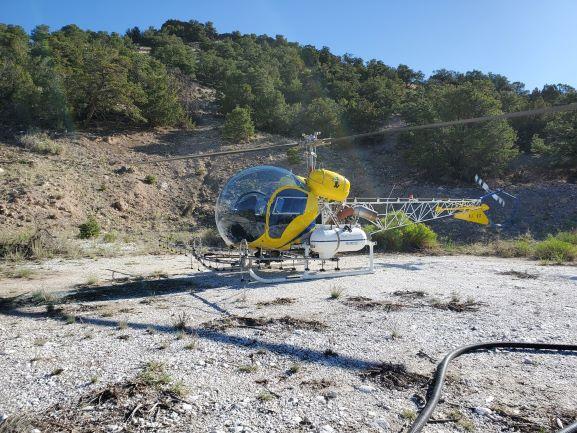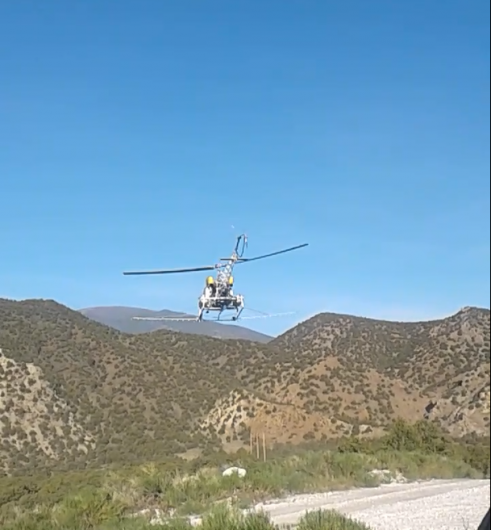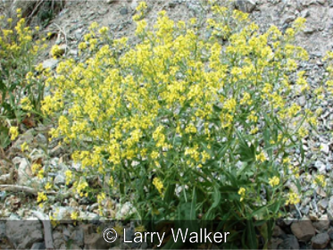You are viewing ARCHIVED content published online before January 20, 2025. Please note that this content is NOT UPDATED, and links may not work. Additionally, any previously issued diversity, equity, inclusion or gender-related guidance on this webpage should be considered rescinded. For current information, visit https://www.blm.gov/blog.
Helicopters help treat inaccessible invasive plant
By Aaron Richter, Fisheries & Riparian and Weeds Program Lead, Royal Gorge Field Office
The Bureau of Land Management Royal Gorge Field Office (RGFO) is home to Colorado’s only infestation of elongated mustard (Brassica elongata), an invasive plant species.
In 2003 and 2004, concerned private landowners reported a suspicious, unknown plant with yellow flowers invading a large area in the rugged terrain of Wellsville, Colorado, largely on BLM-managed land. Fremont County, Chaffee County and the BLM worked with Colorado Department of Agriculture (CDA) and Colorado State University to try and identify the aggressive invader, but the plant was not recognized. A sample was sent to out of state researchers, and it was positively identified in 2005 as elongated mustard.

Elongated mustard is native to southeastern Europe and Asia where it inhabits semi-arid environments and spreads by wind-dispersed seeds in the late summer and early fall. In the U.S., it can be found growing in disturbed soils, along roadsides, and in woodland and desert environments. After its discovery, the elongated mustard was added to the CDA’s noxious weeds list as a List A species, which, by law, must be eradicated.
The BLM, Fremont and Chaffee counties, with support from partners such as CDA, private landowners, and Colorado Parks and Wildlife, began to treat the infestation with herbicide. The plant was competitive against native vegetation and well adapted to a variety of sites from full sun to full shade, fine soils to gravel to rock. It was even found growing in a rocky cave that receives little light or moisture. Spraying with Escort was found to be an effective treatment.

Several years of spraying showed promise for effective control in the areas that could be accessed by ATV or on foot, but much of the terrain that the elongated mustard invaded was too steep and rugged to access without some climbing gear. Binocular observations showed that the infestation was rapidly expanding into inaccessible areas, and ground treatments would be ineffective for containment of the infestation, let alone eradication, which is mandated by law for a list A weed.
The BLM, Fremont and Chaffee counties decided that employing precision spot treatments with a helicopter (which the group had used recently to successfully treat thousands of acres of Tamarisk in the Arkansas Valley) would be the most efficient and effective method to properly inventory and treat the infestation, while minimizing employee exposure to risks such as falls and rattle snake bites.

In 2015, a helicopter spray service was contracted to inventory and spot spray the infestation. A survey flight showed elongated mustard plants were spread over approximately 3,000 acres, and 160 acres of herbicide were applied. In one day, the helicopter accomplished more than could not be done with a large crew on the ground. Since then, the infestation has been treated with a helicopter annually. The bright yellow flowers of the elongated mustard show up easily from the helicopter cockpit and enables the pilot to send targeted bursts of herbicide to the individual plants. Spraying varies yearly and depends on timing of moisture and average temperatures in the infestation area. The number elongated mustard plants within the infestation vary seemingly based on weather patterns. The general overall trend is a decrease in plants and the perimeter of the infestation is no longer expanding, which shows the treatment is effective.
